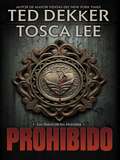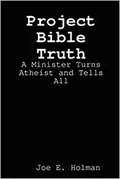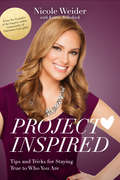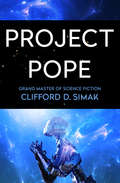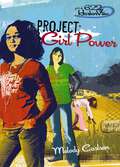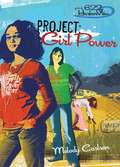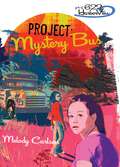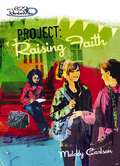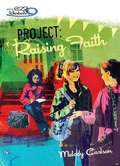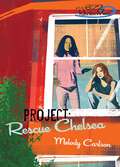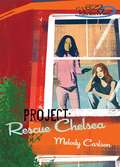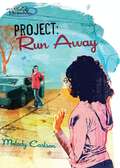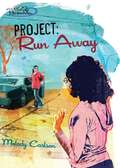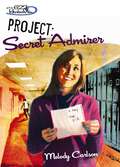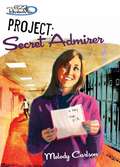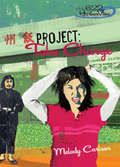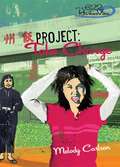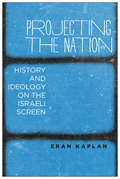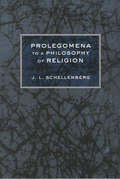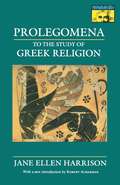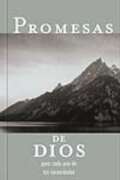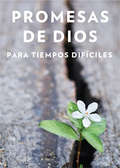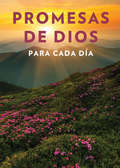- Table View
- List View
Prohibido
by Ted DekkerEN EL AÑO 2005, especialistas en Genética descubrieron el gen humano que controla el temor innato y adquirido. Se denominó Estatmina u Oncoproteína 18. En 15 años se identificaron de forma similar todos los genes que influyen en las principales emociones. Cerca de una década después, tras una guerra catastrófica que destruyó gran parte de la civilización, la humanidad prometió renunciar a todo lo que había conspirado para su destrucción. De las cenizas surgió un nuevo mundo del que fueron eliminadas las tecnologías avanzadas y las emociones apasionadas que llevaron a su ruina. Un mundo sin odio, sin malicia, sin aflicción, sin ira. En general, la única emoción que genéticamente se permitió sobrevivir fue el temor. Durante 480 años, reinó la paz perfecta. Hasta ahora...
Project Bible Truth
by Joe E. HolmanAfter nine years of preaching fundamentalist Christianity for the denomination known as the Church of Christ, minister Joe E. Holman decided to call it quits. Walking away from the ministry forever, Holman explains the reasons for making such a life-altering and controversial decision.
Project Inspired
by Kristin Billerbeck Nicole WeiderNicole Weider is on a mission: to help young girls avoid the traps that culture sets. The trap that baits you into thinking you must sacrifice your self-worth in order to be beautiful and popular. Nicole launched Project Inspired in 2010 (www.projectinspired.com), a website for teen girls that analyzes pop culture and explores ways girls can live in their authentic beauty.In Project Inspired, Nicole shares tips for you to stay true to yourself—to how you were created to be—as well as how to dress modestly yet fashionably, how to make a positive difference in the world, and how to enjoy your teen years while standing firm in your faith. With photographs, real behind-the-scenes stories from inside the fashion world, and an honest look at living a life that looks great on the outside and feels great on the inside, Project Inspired is a book you’ll turn to time and time again.
Project Pope: I Am Crying All Inside And Other Stories, Highway Of Eternity, And Project Pope (The\works Of Clifford D. Simak Ser. #3)
by Clifford D. SimakRobot believers at the far end of the galaxy endeavor to create a true religion, but their efforts could be shattered by a shocking revelation Far in the future, on the remote planet End of Nothing, sentient robots are engaged in a remarkable enterprise. They call their project Vatican-17: an endeavor to create a truly universal religion presided over by a pope, whose extreme godliness and infallible artificial intelligence are fed by telepathic human Listeners who psychically delve into the mysteries of the universe. But the great and holy mission could be compromised by one shocking revelation that threatens to inspire serious crises of faith among the spiritual, truth-seeking robotic acolytes while tearing them into warring religious factions. For the Listener Mary is claiming that she has just discovered Heaven. There are those among the Clifford D. Simak faithful who consider Project Pope his masterpiece. But whether the crowning literary achievement of a multiple Hugo and Nebula Award-winning science fiction Grand Master or merely another brilliant novel of speculative fiction to stand among his many, Simak's breathtaking search for God in the machine ingeniously blends science and spirituality in a truly miraculous way that few science fiction writers, if any, have been able to accomplish.
Project: Girl Power (Faithgirlz / Girls of 622 Harbor View #No. 1)
by Melody CarlsonWritten by bestselling author melody carlson. Meet Morgan, Amy, Carlie, and Emily. They all live in the trailer park at 622 Harbor View in tiny Boscoe Bay, Oregon. Proximity made them friends, but a desire to make the world a better place—and a willingness to work at it—keeps them together. In the first book of this new series, Project: Girl Power,bullies knock Emily from her bike on her way home from school, so the girls start walking together because there’s safety in numbers. With help from other people in the park, they set out to beautify Harbor View. In book two, Project: Mystery Bus, the girls begin summer by working to clean and restore their bus to use as a clubhouse. And thus begins the Rainbow Club. In book three, Project: Rescue Chelsea, Carlie makes a new friend. Chelsea Landers lives in a mansion and isn’t always very kind. Carlie would like a best friend, but will Chelsea fit in with her other friends? In book four, Project: Take Charge, the girls decide to take action when they find out their town’s only city park has been vandalized and may soon be turned into a parking lot. MELODY CARLSON In sixth grade, Melody Carlson helped start a school newspaper called The BuccaNews (her school’s mascot was a Buccaneer—argh!). As editor of this paper, she wrote most of the material herself, creating goofy phony bylines to hide the fact that the school newspaper was mostly a one-“man” show. She lives in Sisters, OR. Visit her at www.MelodyCarlson.com
Project: Girl Power (Girls of 622 Harbor View, Book #1)
by Melody CarlsonAfter a face-off with a group of bullies, Morgan, Amy, Carlie, and Emily decide to walk to and from school together. There's safety in numbers. Then the girls notice how ugly their mobile home park looks. With help from other people in the park, they beautify Harbor View -- even though the bullies vandalize their garden.
Project: Mystery Bus (Faithgirlz / Girls of 622 Harbor View #No. 2)
by Melody CarlsonWritten by bestselling author melody carlson. Meet Morgan, Amy, Carlie, and Emily. They all live in the trailer park at 622 Harbor View in tiny Boscoe Bay, Oregon. Proximity made them friends, but a desire to make the world a better place—and a willingness to work at it—keeps them together. In the first book of this new series, Project: Girl Power,bullies knock Emily from her bike on her way home from school, so the girls start walking together because there’s safety in numbers. With help from other people in the park, they set out to beautify Harbor View. In book two, Project: Mystery Bus, the girls begin summer by working to clean and restore their bus to use as a clubhouse. And thus begins the Rainbow Club. In book three, Project: Rescue Chelsea, Carlie makes a new friend. Chelsea Landers lives in a mansion and isn’t always very kind. Carlie would like a best friend, but will Chelsea fit in with her other friends? In book four, Project: Take Charge, the girls decide to take action when they find out their town’s only city park has been vandalized and may soon be turned into a parking lot. MELODY CARLSON In sixth grade, Melody Carlson helped start a school newspaper called The BuccaNews (her school’s mascot was a Buccaneer—argh!). As editor of this paper, she wrote most of the material herself, creating goofy phony bylines to hide the fact that the school newspaper was mostly a one-“man” show. She lives in Sisters, OR. Visit her at www.MelodyCarlson.com
Project: Raising Faith (Faithgirlz / Girls of 622 Harbor View #No. 5)
by Melody CarlsonWhen the girls set out to raise the money to go on a 3-day ski trip with the church youth group, Morgan is confident that God will provide the funds. But while everyone else finds a way to afford the trip, Morgan’s plans are derailed by her grandmother’s illness, school, Christmas activities, even jealousy … and when Grandma suffers a heart attack, Morgan’s faith is severely tested. Will God provide what’s really important? The girls of 622 Harbor View may not have much, but they’ve got dreams, a desire to make the world a better place, and friendship.
Project: Raising Faith (Girls of 622 Harbor View, Book #5)
by Melody CarlsonThe girls of 622 Harbor View struggle to come up with funds for a three-day snow trip, and Morgan learns some tough lessons on faith.
Project: Rescue Chelsea (Faithgirlz / Girls of 622 Harbor View)
by Melody CarlsonWritten by bestselling author melody carlson. Meet Morgan, Amy, Carlie, and Emily. They all live in the trailer park at 622 Harbor View in tiny Boscoe Bay, Oregon. Proximity made them friends, but a desire to make the world a better place—and a willingness to work at it—keeps them together. In the first book of this new series, Project: Girl Power,bullies knock Emily from her bike on her way home from school, so the girls start walking together because there’s safety in numbers. With help from other people in the park, they set out to beautify Harbor View. In book two, Project: Mystery Bus, the girls begin summer by working to clean and restore their bus to use as a clubhouse. And thus begins the Rainbow Club. In book three, Project: Rescue Chelsea, Carlie makes a new friend. Chelsea Landers lives in a mansion and isn’t always very kind. Carlie would like a best friend, but will Chelsea fit in with her other friends? In book four, Project: Take Charge, the girls decide to take action when they find out their town’s only city park has been vandalized and may soon be turned into a parking lot. MELODY CARLSON In sixth grade, Melody Carlson helped start a school newspaper called The BuccaNews (her school’s mascot was a Buccaneer—argh!). As editor of this paper, she wrote most of the material herself, creating goofy phony bylines to hide the fact that the school newspaper was mostly a one-“man” show. She lives in Sisters, OR. Visit her at www.MelodyCarlson.com
Project: Rescue Chelsea (Girls of 622 Harbor View, Book 3)
by Melody CarlsonIn book three of the Faithgirlz series -- the Girls of 622 Harbor View -- Carlie makes a new friend. Chelsea Landers lives in a mansion and isn't always very kind. Carlie would like a best friend, but will Chelsea fit in with her other friends? When Carlie is betrayed by Chelsea, she learns how much she appreciates her friends in the Rainbow Club. This is a story about forgiveness and accepting differences.
Project: Run Away
by Melody CarlsonThe miraculous power of prayer—to protect, guide, and heal—plays an important role in the sixth adventure of the Girls of 622 Harbor View. Fleeing her abusive ex-husband, Emily’s mother packs up her two children and disappears down a rainy Oregon highway. Emily’s friends are devastated—they haven’t even been on the ski trip yet!—and they’re worried. But what can they do?
Project: Run Away (Girls of 622 Harbor View, Book 6)
by Melody CarlsonShortly before Christmas, Emily's family must flee when her abusive father uncovers them in Boscoe Bay. But Emily's friends rally to help get them safely back home where Emily discovers that forgiveness doesn't always come easily.
Project: Secret Admirer (Faithgirlz / Girls of 622 Harbor View #No. 8)
by Melody CarlsonWhat happens when the boy you like doesn’t like you back? Meet Morgan, Amy, Carlie, and Emily. They all live in the trailer park at 622 Harbor View in tiny Boscoe Bay, Oregon. Proximity made them friends, but a desire to make the world a better place—and a willingness to work at it—keeps them together. The Valentine’s Day dance is on the horizon, and Amy daydreams about the cutest boy in school—after all, someone’s leaving secret admirer notes in her locker. But when news of her crush gets out, she is so embarrassed. What do you do when you’re going to be single on the biggest couples’ night of the year? Amy just might have an answer…helping others who are lonely on the most romantic day of the year!
Project: Secret Admirer (Girls of 622 Harbor View, Book #8)
by Melody CarlsonWith Valentine's Day coming, Amy gets a crush. She also gets notes from a secret admirer and assumes they're from him. But after public humiliation, her heart is broken and, consequently, she develops an idea for others who feel left out of love -- The Lonely Hearts Club.
Project: Ski Trip (Faithgirlz / Girls of 622 Harbor View #No. 7)
by Melody CarlsonCarlie’s mad! Can she forgive her friends—and will they forgive her? Meet Morgan, Amy, Carlie, and Emily. They all live in the trailer park at 622 Harbor View in tiny Boscoe Bay, Oregon. Proximity made them friends, but a desire to make the world a better place—and a willingness to work at it—keeps them together. Friendships are put to the test as the girls go on their long-awaited ski trip with the church youth group. But there are boys on this trip, and some of the girls would rather flirt than ski—and tomboy Carlie would rather snowboard than shower! Then an accident on the slopes forces her to slow down—and shows her who her real friends are.
Project: Ski Trip (Girls of 622 Harbor View, Book 7)
by Melody CarlsonThe girls are ready to hit the slopes, but there are guys on the church youth group trip, too. Some of Carlie's friends are a little boy-crazy, and she becomes fed up with their schemes. She also finds herself caught up in competing with her snowboard, and that lands her in trouble.
Project: Take Charge
by Melody CarlsonWritten by bestselling author melody carlson. Meet Morgan, Amy, Carlie, and Emily. They all live in the trailer park at 622 Harbor View in tiny Boscoe Bay, Oregon. Proximity made them friends, but a desire to make the world a better place—and a willingness to work at it—keeps them together. In the first book of this new series, Project: Girl Power,bullies knock Emily from her bike on her way home from school, so the girls start walking together because there’s safety in numbers. With help from other people in the park, they set out to beautify Harbor View. In book two, Project: Mystery Bus, the girls begin summer by working to clean and restore their bus to use as a clubhouse. And thus begins the Rainbow Club. In book three, Project: Rescue Chelsea, Carlie makes a new friend. Chelsea Landers lives in a mansion and isn’t always very kind. Carlie would like a best friend, but will Chelsea fit in with her other friends? In book four, Project: Take Charge, the girls decide to take action when they find out their town’s only city park has been vandalized and may soon be turned into a parking lot. MELODY CARLSON In sixth grade, Melody Carlson helped start a school newspaper called The BuccaNews (her school’s mascot was a Buccaneer—argh!). As editor of this paper, she wrote most of the material herself, creating goofy phony bylines to hide the fact that the school newspaper was mostly a one-“man” show. She lives in Sisters, OR. Visit her at www.MelodyCarlson.com
Project: Take Charge (Girls of 622 Harbor View, Book 4)
by Melody CarlsonWhen vandals trash McPhearson Park, Amy leads the way as she, Morgan, Carlie, Emily, and Chelsea, the newest club member, make it their project to save the spot from being turned into a parking lot and restore it to a place of beauty and fun.
Projecting the Nation: History and Ideology on the Israeli Screen
by Eran KaplanProjecting the Nation: History and Ideology on the Israeli Screen is a wide-ranging history of over seven decades of Israeli cinema. The only book in English to offer this type of historical scope was Ella Shohat’s Israeli Cinema: East West and the Politics of Representation from 1989. Since 1989, however, Israeli cinema and Israeli society have undergone some crucial transformations and, moreover, Shohat’s book offered a single framework through which to judge Israeli cinema: a critique of orientalism. Projecting the Nation contends that Israeli cinema offers much richer historical and ideological perspectives that expose the complexity of the Israeli project. By analyzing Israeli films which address such issues as the Arab-Israeli conflict, the Ashkenazi-Mizrahi divide, the kibbutz and urban life, the rise of religion in Israeli public life and more, the book explores the way cinema has represented and also shaped our understanding of the history of modern Israel as it evolved from a collectivist society to a society where individualism and adherence to local identities is the dominant ideology.
Prolegomena To A Philosophy Of Religion
by J. L. SchellenbergThere is no attempt here to lay down as inviolable or to legislate certain ways of looking at things or ways of proceeding for philosophers of religion, only proposals for how to deal with a range of basic issues-proposals that I hope will ignite much fruitful discussion and which, in any case, I shall take as a basis for my own ongoing work in the field. -from the Preface Providing an original and systematic treatment of foundational issues in philosophy of religion, J. L. Schellenberg's new book addresses the structure of religious and irreligious belief, the varieties of religious skepticism, and the nature of religion itself. From the author's searching analysis of faith emerges a novel understanding of propositional faith as requiring the absence of belief. Schellenberg asks what the aims of the field should be, setting out a series of principles for carrying out some of the most important of these aims. His account of justification considers not only belief but also other responses to religious claims and distinguishes the justification of responses, propositions, and persons. Throughout Prolegomena to a Philosophy of Religion, Schellenberg is laying the groundwork for an elaboration of his own vision while at the same time suggesting how philosophers might rethink assumptions guiding most of today's work in analytic philosophy of religion.
Prolegomena to the Study of Greek Religion (Mythos: The Princeton/Bollingen Series in World Mythology #142)
by Jane Ellen HarrisonJane Harrison examines the festivals of ancient Greek religion to identify the primitive "substratum" of ritual and its persistence in the realm of classical religious observance and literature. In Harrison's preface to this remarkable book, she writes that J. G. Frazer's work had become part and parcel of her "mental furniture" and that of others studying primitive religion. Today, those who write on ancient myth or ritual are bound to say the same about Harrison. Her essential ideas, best developed and most clearly put in the Prolegomena, have never been eclipsed.
Promesas De Dios
by Jack CountrymanNo hay nada que tranquilice a nuestros corazones y mentes como las promesas de Dios.Promesas de Dios para cada una de tus necesidades ofrece el consuelo y la esperanza que sólo se encuentran en la Palabra de Dios. No importa cuál sea tu situación, ¡Dios tiene una promesa para ti!Algunas de las promesas que se abarcan incluyen:EternidadAmorPacienciaSeguridadPerdónEl Espíritu SantoLa fidelidad de Dios
Promesas de Dios en tiempos difíciles
by Jack CountrymanSi tú o alguien que conoce se enfrenta a la pena y al dolor, a menudo es difícil encontrar las palabras adecuadas para brindar el consuelo y el apoyo que se necesita. Promesas de Dios® para tiempos difíciles es extremadamente útil ya que ofrece 58 temas de promesas seleccionadas de las Escrituras, acerca del consuelo y la esperanza. Ya sea que te encuentres luchando contra la enfermedad, la pérdida, el divorcio, la confusión, la duda sobre Dios, o cualquier otra situacián difícil; las promesas que se encuentran en la Palabra de Dios brindan abundante tranquilidad y una sanación continua al caminar a través de tiempos difíciles. Este es un regalo maravilloso y duradero para aliviar el dolor y alentar al corazón. Una maravillosa selección de las Escrituras enfocadas en la esperanza, el ánimo y el consuelo para tiempos difíciles.
Promesas de Dios para cada día
by Jack CountrymanPromesas de Dios para cada día es una compilación de 1,275 versículos tomados de la Santa Biblia. La primera sección está dedicada a conocer a Jesús como nuestro salvador, señor, amigo, hermano, protector, liberador, compañero y guia. Las siguientes secciones tratan temas sobre qué hacer cuando te sientes desanimado, preocupado, solitario, deprimido, confundido, tentado, enojado, rechazado, temeroso, desesperado, estresado, infeliz, no te sientes importante, enfermedades, problemas económicos, cuando nada parece ir bien. También incuye pasajes bíblicos sobre la fe, el amor, la vida eterna, la muerte, la alabanza, el servicio a Dios, la obediencia, el comportamiento sexual, las drogas, la gracia de Dios, el Espíritu Santo, la fidelidad de Dios, la Iglesia, el discipulado. , la mayordomía, Satanás, la guerra espiritual, el infierno, el regreso de Cristo, los no salvos y las cualidades de el cristiano. La última sección, está dedicada al plan de salvación de Dios.
